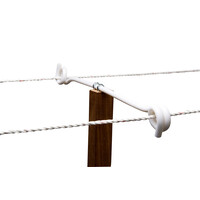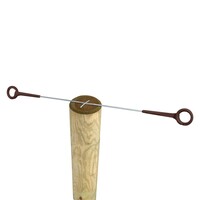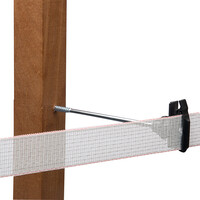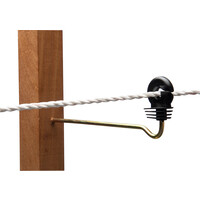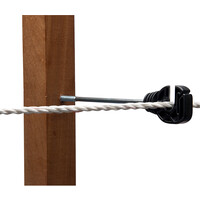Electric fencing with offset insulators
A typical fence is equipped with offset brackets to support an electrified wire (or wires) on one or both of the fence's sides. The wire prevents animals from brushing up against the fence or pushing against it, hence increasing the fence's lifespan. There are many offset brackets available to place straight into the wires of an existing nonelectric fence, wood post fences, steel fences, or both (barbed wire, chain link, etc.). See below for the suggested offset electric fence setup for cattle, sheep, pigs, goats, and horses after selecting your offset brackets.
If you wish to secure an existing or brand-new non-electric fence, retrofit electric fencing is a practical and simple solution.
Types of Offset fence insulators
There are some different types of Offset electric fence insulators, such as Live tip offsets, Ring top offsets and Wire offsets. these insulators are ideal as permanent insulators.
Live tip offsets
Live tips are one of the various choices for offsets. By deterring animals from rubbing against the offset, the electrified end safeguards the offset. Live tip offsets can be post installed on steel or wood posts. By discouraging stock from rubbing up against them, the electrified tip lessens damage to the offset.
Ring top offsets
For wood post fences, a side mount ring top offset is a popular choice. It offers total flexibility for the offset wire positioning. High tension spring wire that has been galvanised is used to make ring top offsets. The top or side of wooden posts are stapled with this offset. There are additional variations with double ends.
Wire offsets
Traditional fences are further protected by offset wire mounts. This safeguards your fence investment and increases the fence's lifespan. Galvanized high tension spring wire is used to make wire offsets, which twist onto pre-existing fence wires.
Choosing Offset insulators
By securing offset brackets with electrified wire that is insulated on one or both sides of the fence, conventional fences can be extended in lifespan by a number of years. Electric Fence Online advises fastening a single offset wire at a height that is two thirds that of the target animal. It is preferable to utilise two offset wires when sheep and cattle are present in the same region (one for sheep, one for cows). However, both animal kinds can be kept out of the fence by using a single wire that is three quarters the height of a sheep. The old fence will need to be repaired if the wires are frayed or knotted. If you don't, you run the danger of accidentally shorting the electric offset wire with loose non-electric wires. Change the weakest wires and, if feasible, strengthen the others.
Tips for using Offset fence insulators
Use of soft wire for the fence wire and the offset bracket is the most typical mistake. The fence wire should always be made of high tensile wire, and the offset brackets should only be made of spring steel wire. In order to avoid being tangled in the wire of the old fence and shorting out, the bracket needs to be able to spring back into position after contact.
The use of brackets that are too short, causing the live wire to remain too close to the fence it is attached to, is the second most typical error. The live wire should be supported by brackets 150–300mm away from the existing fence.
The live wire's location and height are also crucial. It should be fastened at a height that is two-thirds that of the animal to be restrained. On the same fence, two offset wires can be put and are frequently done. A wire is positioned at 750mm on one side to corral livestock and at 200mm on the other to deter predators.
Even though offset fence is easy to use, it still needs to be considered a system. One shortcut or one component of low quality might render the fence useless.
Offset Fence Set Up
- Cattle (7-14m): 700-900mm offset bracket height
- Pigs, Sheep, Goats (7-14m): 500mm offset bracket height
- Horses (7-14m): 1000mm offset bracket height





